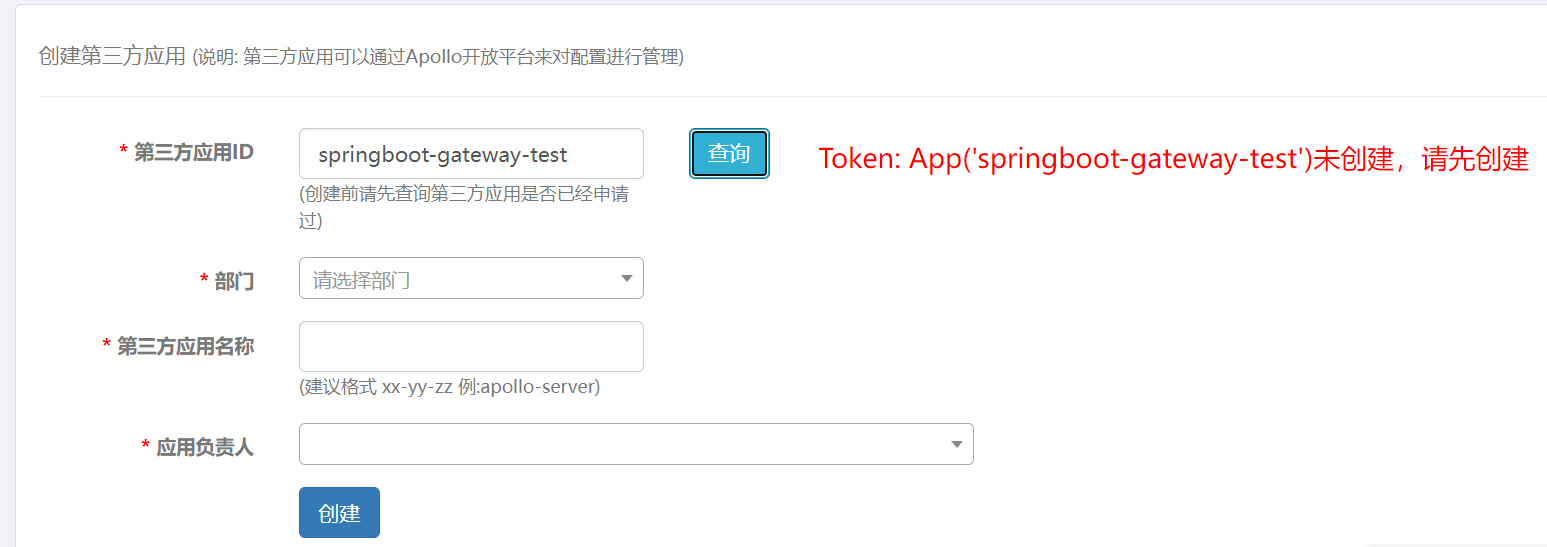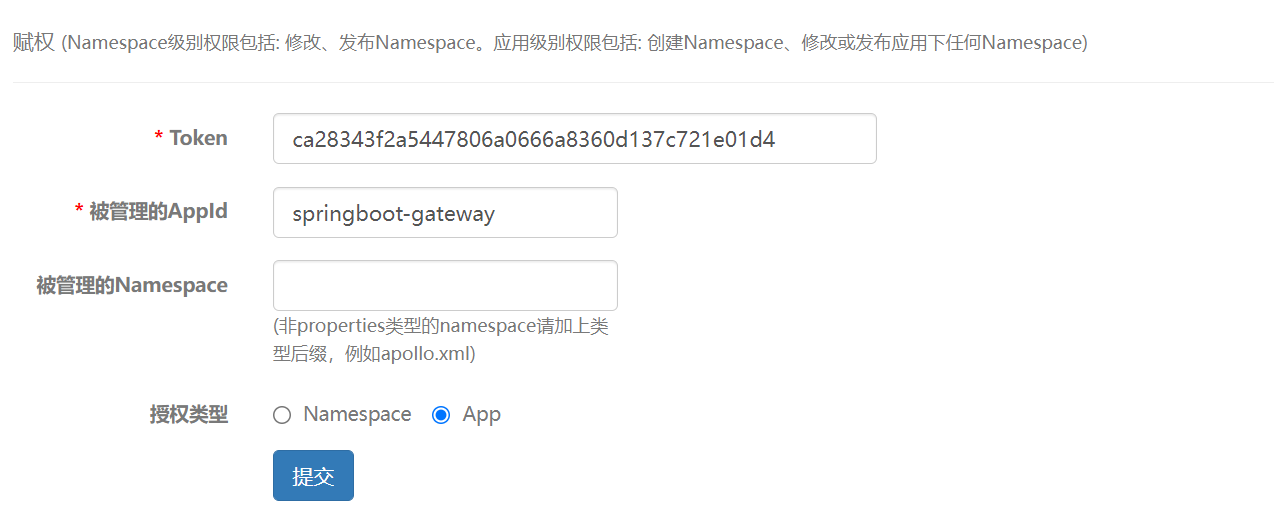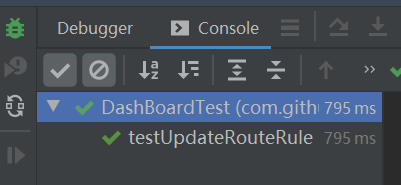前言
落地过微服务项目的朋友,对配置中心应该都不会陌生。利用配置中心可以集中化管理配置,还可以做到配置热更新等。目前市面常见的配置中心有QConf、spring-cloud-config、diamond、disconf、apollo、nacos等。而微服务项目最常用应该是spring-cloud-config、apollo、nacos。
我们可能会有这样的应用场景,将一些配置数据先落到数据库,然后再将这些数据持久化到配置中心。这边可以分成2步走,第一步将数据落库,第二步再手动通过配置中心提供的面板,将数据写到配置中心。不过可能我们会更倾向,将数据落库后,直接将数据同步到配置中心。今天就以apollo为例,聊聊如何将数据同步到apollo配置中心
实现思路
利用apollo提供的开放API进行操作
实现步骤
1、将我们的应用接入Apollo开放平台
Apollo管理员在 http://{portal_address}/open/manage.html 创建第三方应用,创建之前最好先查询此AppId是否已经创建。创建成功之后会生成一个token,如下图所示:
2、给已注册的应用授权
Apollo管理员在 http://{portal_address}/open/manage.html 页面给token赋权。赋权之后,应用就可以通过Apollo提供的Http REST接口来管理已授权的Namespace的配置了
3、应用调用Apollo Open API
示例演示
以将API网关路由信息同步到apollo为例
1、创建第三方应用
创建后提示token
2、根据token给第三方应用授权操作的appId
我们授权可以操作API网关上的所有配置,授权类型为APP
3、通过apollo-openapi调用Apollo Open API
项目中pom导入apollo-openapi坐标
<dependency>
<groupId>com.ctrip.framework.apollo</groupId>
<artifactId>apollo-openapi</artifactId>
<version>1.7.0</version>
</dependency>
引入后,我们就可以直接操作apollo open api了
a、查询配置项
public long getMaxRouteRuleIndex(){
OpenNamespaceDTO openNamespaceDTO = apolloOpenApiClient.getNamespace(appInfoProperties.getAppId(),appInfoProperties.getEnv(),appInfoProperties.getClusterName(),appInfoProperties.getNameSpaceName());
List<OpenItemDTO> items = openNamespaceDTO.getItems();
if(CollectionUtils.isEmpty(items)){
return 0;
}
return items.stream().filter(item -> item.getKey().matches(ID_PATTERN)).count();
}
运行单元测试
@Test
public void testGetMaxRouteRuleIndex(){
long index = routeService.getMaxRouteRuleIndex();
Assert.assertTrue(index >= 0);
}
此时网关上的apollo面板
b、创建并发布配置项
注: apollo的创建和发布是两个不同的API
public boolean createRouteRule(RouteRule routeRule){
try {
long curRouteRuleIndex = getMaxRouteRuleIndex();
buildOpenItemDTO(ROUTE_ID_KEY,curRouteRuleIndex,routeRule.getRouteId(),true);
buildOpenItemDTO(ROUTE_URI_KEY,curRouteRuleIndex,routeRule.getUri(),true);
buildOpenItemDTO(ROUTE_PREDICATES_KEY,curRouteRuleIndex,routeRule.getPredicate(),true);
buildOpenItemDTO(ROUTE_FILTERS_KEY,curRouteRuleIndex,routeRule.getFilter(),true);
return publish("新增网关路由","新增网关路由");
} catch (Exception e) {
log.error("{}",e.getMessage());
}
return false;
}
运行单元测试
@Test
public void testCreateRouteRule(){
RouteRule routeRule = RouteRule.builder().routeId(appName)
.uri("http://localhost:8082")
.predicate("Path=/dashboard/**")
.filter("StripPrefix=1").build();
boolean isSuccess = routeService.createRouteRule(routeRule);
Assert.assertTrue(isSuccess);
}
查看api网关在apollo portal上的面板
发现出现一条路由配置。因为api网关做了动态路由,因此从api网关的控制台可以发现如下输出
访问一下浏览器
动态路由生效
b、更新并发布配置项
public boolean updateRouteRule(RouteRule routeRule){
long ruleIndex = getRouteRuleIndex(routeRule.getRouteId());
if(ruleIndex != -1){
try {
buildOpenItemDTO(ROUTE_URI_KEY,ruleIndex,routeRule.getUri(),false);
buildOpenItemDTO(ROUTE_PREDICATES_KEY,ruleIndex,routeRule.getPredicate(),false);
buildOpenItemDTO(ROUTE_FILTERS_KEY,ruleIndex,routeRule.getFilter(),false);
return publish("更新网关路由","更新网关路由");
} catch (Exception e) {
log.error("{}",e.getMessage());
}
}
return false;
}
运行单元测试
@Test
public void testUpdateRouteRule(){
RouteRule routeRule = RouteRule.builder().routeId(appName)
.uri("http://localhost:8082")
.predicate("Path=/xxx/**")
.filter("StripPrefix=1").build();
boolean isSuccess = routeService.updateRouteRule(routeRule);
Assert.assertTrue(isSuccess);
}
查看api网关在apollo portal上的面板
可以发现此时predicate的Path已经改为xxx
查看API网关控制台
访问一下浏览器,原先访问http://localhost:8000/dashboard/ops/index会出现
改访问http://localhost:8000/xxx/ops/index
说明路由已经成功发生变更
b、删除并发布配置项
public boolean deleteRouteRule(String routeId){
long ruleIndex = getRouteRuleIndex(routeId);
if(ruleIndex != -1){
try {
// removeRouteItem(ROUTE_URI_KEY,ruleIndex);
// removeRouteItem(ROUTE_PREDICATES_KEY,ruleIndex);
// removeRouteItem(ROUTE_FILTERS_KEY,ruleIndex);
buildOpenItemDTO(ROUTE_URI_KEY,ruleIndex,"http://null",false);
buildOpenItemDTO(ROUTE_PREDICATES_KEY,ruleIndex,"Path=/-9999",false);
return publish("删除网关路由","删除网关路由");
} catch (Exception e) {
log.error("{}",e.getMessage());
}
}
return false;
}
private void removeRouteItem(String key,long index){
if(key.equalsIgnoreCase(ROUTE_PREDICATES_KEY) || key.equalsIgnoreCase(ROUTE_FILTERS_KEY)){
key = String.format(key,index,0);
}else{
key = String.format(key,index);
}
apolloOpenApiClient.removeItem(appInfoProperties.getAppId(),appInfoProperties.getEnv(),appInfoProperties.getClusterName(),appInfoProperties.getNameSpaceName(),key,appInfoProperties.getAuthUser());
}
注: 因为网关删除相对复杂点,涉及到路由集合重算,这边取巧采用更新成无法访问的路由。如果是物理删除直接,调用apollo的removeItem即可
总结
apollo开放平台提供的api其实就是http restful操作,提供一系列的增删改查操作。这边有个小细节就是apollo的增删改和发布是分开操作。如果只调用增删改,则需要在portal上点发布,或者利用发布接口进行操作。更多细节可以查看apollo的开放平台链接
本文提供的示例,仅做参考,不可直接用于生产环境。如果有朋友的配置中心是用nacos,也是可以实现类似的操作。因为nacos也有提供open api接口,感兴趣朋友可以查看如下链接
demo链接
共同学习,写下你的评论
评论加载中...
作者其他优质文章



















